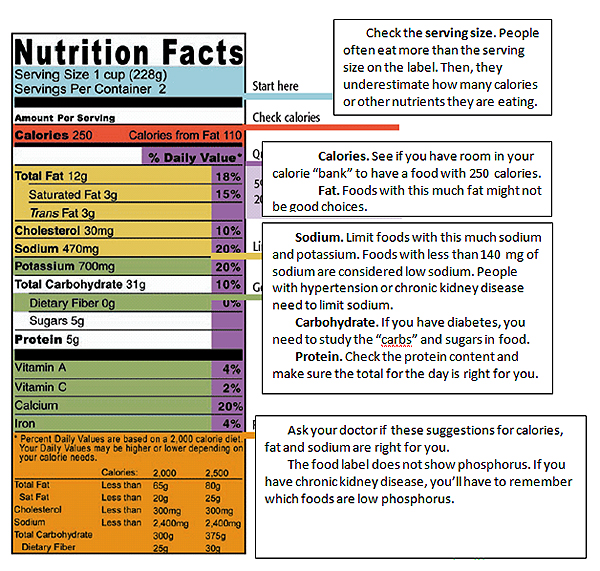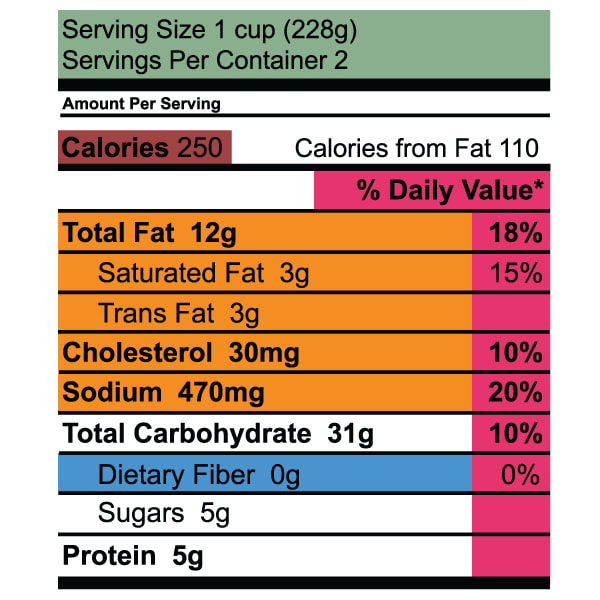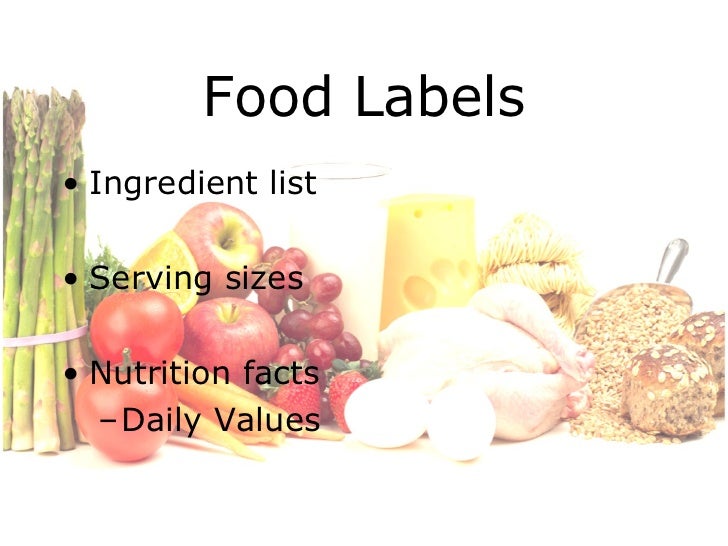38 nutritional labels on food are based on a diet of
Food Labels 101: Understanding the Nutrition Facts Label Nutrition labels are based on a daily 2,000 calorie diet. Depending on your age, gender and activity level, you may need to consume more or less than 2,000 calories per day, so keep this in mind when viewing each label. Now let's take a look at the parts of the nutrition facts label and break it all down. Anatomy of a Nutrition Facts Label How to Understand and Use the Nutrition Facts Label | FDA Feb 25, 2022 · Overview. The information in the main or top section (see #1-4) of the sample nutrition label (below) can vary with each food and beverage product; it …
Leading Nutritional Analysis, Calculator & Labelling Software Food Manufacturing. Save thousands in lab and consulting fees by bringing nutrition analysis in house. With MenuSano, create compliant nutrition fact labels, store recipes securely in the cloud and conduct virtual recipe experimentation.

Nutritional labels on food are based on a diet of
This Is How to Read a Nutrition Facts Label on the Keto Diet Each nutrient listed on the label refers to the amount of that label contained in one serving, which is usually not the entire package. For instance, if "Total Carbohydrates" are listed as 10 grams (10 g), that's accurate for one serving. Make Your Own Food Nutrition Facts Labels! - Shop'NCook The display of the food nutrition facts label works best with a recent version of Google Chrome or Safari browsers. To report problems or make suggestions, use our online form . DISCLAIMER: This tool is made available in the hope that it will be useful, but WITHOUT ANY WARRANTY; without even the implied warranty of MERCHANTABILITY or FITNESS ... Nutritional Needs of Puppies - WebMD The Importance of a Balanced Diet. Your puppy needs a balanced diet, which is found in many store-bought dog foods or can be prepared at home with the advice of your vet. A balanced diet gives your buddy energy, keeps their brain and body humming, and helps them grow. When you buy puppy food, look for these words on the label:
Nutritional labels on food are based on a diet of. › pmc › articlesNutritional Update for Physicians: Plant-Based Diets - PMC A healthy, plant-based diet requires planning, reading labels, and discipline. The recommendations for patients who want to follow a plant-based diet may include eating a variety of fruits and vegetables that may include beans, legumes, seeds, nuts, and whole grains and avoiding or limiting animal products, added fats, oils, and refined ... How to Read Food Labels for a Heart-Healthy Diet - Hopkins Medicine The correct answer is A 2,000-calorie-a-day diet. The percent daily value numbers on a Nutrition Facts label are based on a 2,000-calorie diet. You may need to eat more or fewer calories and nutrients depending on your size, health status, health goals and doctor's recommendation. shopncook.com › nutritionFactsLabelMake Your Own Food Nutrition Facts Labels! - Shop'NCook The display of the food nutrition facts label works best with a recent version of Google Chrome or Safari browsers. To report problems or make suggestions, use our online form . DISCLAIMER: This tool is made available in the hope that it will be useful, but WITHOUT ANY WARRANTY; without even the implied warranty of MERCHANTABILITY or FITNESS ... › food › new-nutrition-facts-labelHow to Understand and Use the Nutrition Facts Label | FDA Feb 25, 2022 · Overview. The information in the main or top section (see #1-4) of the sample nutrition label (below) can vary with each food and beverage product; it contains product-specific information ...
nutritionistpro.comNutritionist Pro™ | Diet Analysis, Food Label, Menu Creation ... Designed and managed by registered dietitians for your comprehensive nutrition analysis needs. From food labels to menus to recipe calculations, Nutritionist Pro™ makes all your food science needs a simple and streamlined process. Since 1982 over 1,000,000 have relied on the Nutritionist Pro™ family of products. Consumer Research on Labeling, Nutrition, Diet, and Health - U.S. Food ... On diet and health, the survey asks about (1) awareness of the relationship between diet and diseases (cancer, heart disease, high blood pressure), (2) knowledge of fats and cholesterol, (3)... 37491 Dog P01 16 07/24/06 4:47 PM Page 1 YOUR DOG’S … Scientific research has shown that an adult dog’s daily diet can contain up to 50% carbohydrates by weight, including 2.5–4.5% from fiber. A minimum of approximately 5.5% of the diet should come from fats and 10% from protein. Determining Grams of … Understanding Food Nutrition Labels - Heart Remember that the information shown in the label is based on a diet of 2,000 calories a day. You may need less or more than 2,000 calories depending upon your age, gender, activity level, and whether you're trying to lose, gain or maintain your weight.
Nutritionist Pro™ | Diet Analysis, Food Label, Menu Creation … Designed and managed by registered dietitians for your comprehensive nutrition analysis needs. From food labels to menus to recipe calculations, Nutritionist Pro™ makes all your food science needs a simple and streamlined process. Since 1982 over 1,000,000 have relied on the Nutritionist Pro™ family of products. Nutrition Facts Label 101: What Are You Eating? - Fit Father Project The main components of nutrition facts labels, and ways to evaluate each section to optimize food choices, are as follows: Serving Size. On the top of nutrition facts labels, you can view the serving size for food items in question. Serving size on a food label might be 1 cup, 2 tablespoons, 1 package, or something similar. Why nutrition labels on food products? - MedClique The nutritional label: It provides the number of fats, carbohydrates, sodium, sugar, protein, vitamin, and mineral intake based on a 2000 calorie diet. The ingredient list: The ingredient list ultimately derives the nutritional value as well as help you to choose the product of your choice. Recommended daily intake: You can find the most ... How to Read and Interpret Nutrition Labels - Cecelia Health The % Daily Value (%DV) is the percentage of the Daily Value for each nutrient in a serving of the food. The Daily Values are reference amounts (expressed in grams, milligrams, or micrograms) of nutrients to consume, or not to exceed each day, based on a 2000 calorie per day diet.

Nutrition Chart: Real Food doesn't have labels- Products have labels! #awareness | Nutrition ...
SELF Nutrition Data | Food Facts, Information & Calorie Calculator Find nutrition facts, including food labels, calories, nutritional information and analysis that helps promote healthy eating by telling you about the foods you eat. in ... and can help you determine if the food aligns with common macronutrient-based diet plans, such as low-carb (e.g Atkins™ or South Beach™), low-fat, high-protein, or Zone
RDA on Nutritional Labels - What It Means • Cathe Friedrich The RDA value is based on a 2,000-calorie diet and is used to provide guidelines for specific age and sex groups. Its purpose is to tell you the minimum amount of each nutrient you should consume in a day. The National Academy of Medicine establishes these values, and they vary for each nutrient. The RDA Isn't Perfect
Activity: Food Labels and Serving Sizes • Read Nutrition Facts labels to understand the properties of that food. • Determine the recommended serving of a food item. • Understand the importance of following recommendations for serving sizes and choosing foods based on their nutritional qualities. Audience . 5. th. grade to adult . Materials • Food Labels and Serving Sizes
Nutrition Facts Label Flashcards - Quizlet What things must be listed on the Nutrition Facts Label? Total fat, saturated fat, trans fat, cholesterol, sodium, total carbohydrate, dietary fiber, sugars, protein, vitamin A, vitamin C, calcium, and iron What is cholesterol? A waxy, fat-like substance mainly produced in the liver and is found in all cells
3.4 Dietary Recommendations and Nutrition Labels - University of Minnesota A healthy eating pattern includes: A variety of vegetables from all of the subgroups—dark green, red and orange, legumes (beans and peas), starchy, and other. Fruits, especially whole fruits. Grains, at least half of which are whole grains. Fat-free or low-fat dairy, including milk, yogurt, cheese, and/or fortified soy beverages.
Nutritional Update for Physicians: Plant-Based Diets - PMC A healthy, plant-based diet requires planning, reading labels, and discipline. The recommendations for patients who want to follow a plant-based diet may include eating a variety of fruits and vegetables that may include beans, legumes, seeds, nuts, and whole grains and avoiding or limiting animal products, added fats, oils, and refined ...
pets.webmd.com › dogs › feeding-puppyNutritional Needs of Puppies - WebMD The Importance of a Balanced Diet. Your puppy needs a balanced diet, which is found in many store-bought dog foods or can be prepared at home with the advice of your vet. A balanced diet gives your buddy energy, keeps their brain and body humming, and helps them grow. When you buy puppy food, look for these words on the label:

An example of the FDA's proposed nutrition label to replace the one that's been around since the ...
› en › healthy-livingUnderstanding Ingredients on Food Labels | American Heart ... Mar 06, 2017 · Food labels are an important source of information about calories and the nutritional value of the foods you eat, a crucial tool in building a heart-healthy diet. The Nutrition Facts information is always displayed in the same orderly fashion and helps you understand how much of certain nutrients that you need to limit are contained in the ...
The % daily values information on a food label is based on a diet of ... User: The % daily values information on a food label is based on a diet of ___ calories. Weegy: The % daily values found on a food label are based on a 2,000-calorie diet. Score 1. User: Low fat used on a food label means there are fewer than ____ grams of fat per serving. Weegy: Low fat used on a food label means there are fewer than 3 grams ...
Learn How the Nutrition Facts Label Can Help You Improve Your Health The Nutrition Facts label on packaged foods is based on updated science and dietary recommendations for Americans. Using the label can help you choose foods for a healthy diet. The label is required on all packaged foods made in the United States and imported from other countries.
Nutrition Labeling - an overview | ScienceDirect Topics Whilst 'salt' is not officially identified in the Directive as a 'nutrient', sodium information on many labels is being supplemented by a 'salt equivalent' figure, based usually on the formula salt = sodium × 2.5. The current Directive requires the nutrition information to be given per 100 g/ml.
Calories, Nutrition Facts, and Food Labels - Quizizz Play this game to review General Health. A nutrition facts label is based off of a _____ calorie diet Preview this quiz on Quizizz. QUIZ NEW SUPER ... A nutrition facts label is based off of a _____ calorie diet. answer choices . 2000. 2500. 3000. 1500 2000 ... A food label on a bag of chips shows that it contains 100 calories per ...
How to Read Nutrition Labels and Eat Healthy - Scripps Health The new Nutrition Facts Label on food packages has made it easier for people to make healthy eating choices when shopping for groceries. ... While information on the nutrition label is based on a 2,000-calorie a day diet, your calorie needs may be higher or lower, depending on your age, sex and physical activity level. ...
Learn How to Read a Nutrition Label | MamaSezz Whole Food Plant Based ... These products are most definitely not whole food plant-based. Look for minimal ingredients and for ingredients that you recognize as real, whole food. 2. Sodium The American Heart Association recommends 2,300 mg of sodium a day (and they say 1,500 mg is even better). Some studies suggests we need as little as 125 mg a day.
Understanding Food Labels | The Nutrition Source | Harvard T.H. Chan ... Under the Food Allergen Labeling and Consumer Protection Act of 2004, eight major food allergens—milk, fish, tree nuts, peanuts, shellfish, wheat, eggs, and soybeans—are required to be listed in a "contains" statement near the Ingredients list if present in a food. An example would be "contains wheat, milk, and soy."
Food Label Claims: What You Can and Can't Trust - WebMD Multiply the serving size by the number of servings in the package to find out the total calories and nutrients. Percent Daily Value (%DV). This number is based on a 2,000-calorie diet. The %DV...











Post a Comment for "38 nutritional labels on food are based on a diet of"